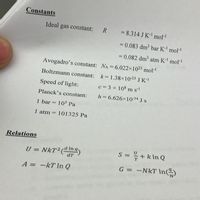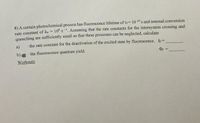Question

Transcribed Image Text:Constants
Ideal gas constant:
= 8.314 J K mol-
= 0.083 dm bar K mol
= 0.082 dm atm K mol
Avogadro's constant: NA = 6.022x1023 mol-!
Boltzmann constant: k 1.38x1023 J K
Speed of light:
c = 3 x 10% m s
Planck's constant:
h = 6.626x1034 J s
1 bar = 105 Pa
1 atm = 101325 Pa
Relations
U = NKT²(n
= + k In Q
S =
%3D
A = -kT In Q
G = -NkT In)
R.

Transcribed Image Text:8) A certain photochemical process has fluorescence lifetime of tr=10-10 s and internal conversion
rate constant of kie = 10" s . Assuming that the rate constants for the intersystem crossing and
quenching are sufficiently small so that these processes can be neglected, calculate
a)
the rate constant for the deactivation of the excited state by fluorescence. ky=
b)
the fluorescence quantum yield.
Workouts
Expert Solution
This question has been solved!
Explore an expertly crafted, step-by-step solution for a thorough understanding of key concepts.
This is a popular solution
Trending nowThis is a popular solution!
Step by stepSolved in 4 steps

Knowledge Booster
Similar questions
- a) Write down the expression for the quantized energy levels, En, of a particle of mass m in an infinite square well of width L. b) State the frequency of a photon that would be emitted from a particle transitioning from the n = 2 energy level to the n = 1 energy level of this infinite square well.arrow_forwardQUESTION 1 IR radiation can. ionize atoms. cause valence e-1 transitions. induce rotations in molecules. cause inner-shell el transitions.arrow_forwarddescribe and explain the benefits and limitations of x raysarrow_forward
- The observed fluorescence lifetime in the absence of a quencher is 1.4 ns. In the presence of a quencher the fluorescence lifetime is 0.8 ns. Calculate the quenching efficiency. which is the ratio of the f luorescence quantum yieldsin the presence and absence of the quencher. φF/φF,0.arrow_forwardNeeds Complete solution with 100 % accuracy don't use chat gpt or ai.arrow_forwardMaterial Si Ge GaAs effective mass parameters: Electron Effective Mass 1.08mo 0.55mo 0.067mo Determine the number of quantum states [er unit volume (3D mate- rial) #/cm³ at T=300K for Si, Ge, and GaAs at an energy of E = kT. What do you observe about the relationship between effective mass and the # of states.arrow_forward
- For a given value of l , what are the allowed values of ml ? What are the allowed values of ml for a given value of n ? Give an example in each case.arrow_forwardIn a H-atom series, the shortest wavelength transition is registered at 821 nm. plsease explain the step by step (1) Identify the transition. (2) Calculate the energy of the above transition in J and eV. (3) What is this series? (4) Calculate the longest wavelength in the series?arrow_forward
arrow_back_ios
arrow_forward_ios